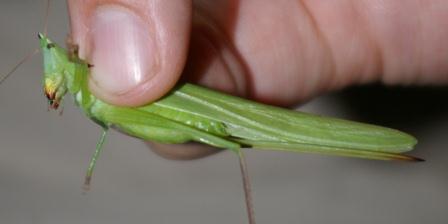by Carl Strang
[Note: Gideon later wrote to share his conclusion that the coneheads we collected were in fact marsh coneheads. The individuals in that population are larger than the ones he was familiar with in Missouri, and the strange gray underside of the cone also was misleading. He later found slender coneheads in another part of their range.] Gideon Ney, Nathan Harness and I reconvened at Indiana Dunes National Lakeshore. We set up camp, but then had to wait out a long afternoon rain wondering if it would stop, if an evening’s search would be any good. The rain stopped an hour before dusk, and we set out prepared to wade through tall wet marsh grasses. We stopped at a corner of the Lakeshore’s Great Marsh, and traded stories as the light faded away. We started hearing the shrill buzzes of coneheads, and began to stalk them. Some of the early ones appeared to be marsh coneheads (Neoconocephalus palustris), which Gideon and Nathan had encountered in Missouri. Then we started catching different ones, and Gideon became increasingly excited as he ticked off characteristics, ultimately concluding that these were the long-sought slender coneheads.

Slender coneheads have medium-sized cones with nearly all the underside darkly pigmented. The Nebraska conehead is similarly marked, but occurs in wooded habitat rather than marsh, and has an interrupted rather than a continuous song.
Most of the ones we found were brown rather than green.
Nathan also found plenty of meadow katydids to study back in the lab.

They took live katydids back to Missouri, so they can record their songs under controlled conditions in the lab and then get detailed DNA and other biochemical analyses to compare to other conehead species.
Ultimately Gideon hopes to collect slender coneheads from several locations. This species is interesting because it occurs in scattered, separated locations from the Atlantic coast to a site in northwest Illinois. How will its population genetics reflect this indication of a storied evolutionary history?
The night had one concluding chapter, which I’ll share in the next post.




